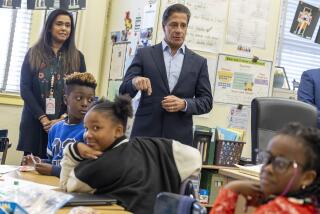Schools learning a lesson over vacation
- Share via
Ana Morales, her husband and their three children packed their 2001 blue van last week and started a 30-hour drive to spend the holidays with Morales’ six siblings in Parral in the Mexican state of Chihuahua.
With their oldest child in kindergarten, Morales feared they wouldn’t be able to visit because he would miss too much school.
But the trip is possible because his Moreno Valley school has extended its winter break this year to three weeks.
“If it weren’t for this longer vacation, we probably wouldn’t go,” said Morales, who has lived in the United States for eight years.
School districts statewide are increasingly stretching winter breaks to accommodate students who visit family in far-flung locales for the holidays.
The trend is particularly noticeable in districts with large Latino populations, because of the many families that head south of the border to celebrate Christmas and Dia de los Reyes on Jan. 6.
In addition to Moreno Valley Unified, districts in Santa Ana, Napa and Rowland Heights are among those that have tacked an extra week onto their traditional two-week breaks this year. They are making up the difference by adding extra school days at the beginning and end of the school year.
“It gives [families] a lot of options and flexibility,” said Maria Ott, superintendent of the 17,000-student Rowland Unified School District in the San Gabriel Valley, which extended this year’s winter break from Dec. 18 through Jan. 8 to accommodate Latino and Asian family vacations. Also, district officials said they had noticed an increase in illnesses near the holidays and said the extra time would allow students to rest.
State law requires 180 instructional days, but beyond that, calendars are largely decided by local school boards and teachers unions.
Scheduling often takes into account the varying needs of the district and the local population.
Overcrowded districts adjust their schedules to get the most use of their facilities. In Los Angeles Unified, students on a traditional school calendar track receive three weeks of winter break under a contract negotiated with the teachers union a decade ago, but students on year-round tracks who are in session during the winter receive one or two weeks off.
Districts in Laguna Beach, Palo Alto and Larkspur break for “ski week” halfway between winter recess and spring break. The Lamont School District in Kern County, which has a large population of migrant workers, schedules four weeks off during the holidays.
“The world is changing, and our schools need to recognize the changing needs of our students,” said Hilary McLean, spokeswoman for the California Department of Education.
In addition to being good for children’s educations because they miss fewer days of class, expanded winter breaks also benefit districts’ finances. State funding is determined by daily attendance, with districts receiving roughly $30 per child per day.
“We lose funding for every day they’re not here,” said Gretchen Mounier, principal of Evergreen Elementary School in West Sacramento, which is on break from Dec. 23 through Jan. 16.
Don Trigg, associate superintendent of business services at Santa Ana Unified, said his nearly 59,000-student district lost tens of thousands of dollars a day because of increased absenteeism around the holiday break in the past.
So this year, when the district streamlined its calendar to place all students on the same schedule, it added a week to winter break to recoup some of the lost funding.
Francisco Lopez, who teaches English-language learners at Vista Heights Middle School in Moreno Valley, said that in the past, his 32-student classrooms would shrink by as much as a third around the holidays. Students whose vacations extended beyond the then-two-week break missed valuable instructional time, he said.
“After Christmas break or any break, you’re beginning a new chapter or a new lesson,” Lopez said. Students “would miss a lot of dialogue, a lot of classroom discussion that would help unlock the curriculum. For some students, it is very easy to catch up.... For others, it’s not so easy, because their abilities, especially their English comprehension, might be lower. Without that classroom discussion and teacher input, that could be debilitating.”
He emphasized that the vacations to students’ family homelands are meaningful.
“A lot of times, this is their only vacation,” he said. “Without these trips, their knowledge and experiences would be very limited, would be sheltered to being in Moreno Valley.”
Silvia Grijalva agrees. Moreno Valley Unified’s extended vacation will allow her 5- and 6-year-old children to spend the holidays in Mexicali with grandparents they rarely see.
“School is more important than anything,” the Moreno Valley woman said. “But this is better, because they can see my parents more. And I can take my time there.”
jennifer.delson@latimes.com
More to Read
Sign up for Essential California
The most important California stories and recommendations in your inbox every morning.
You may occasionally receive promotional content from the Los Angeles Times.














